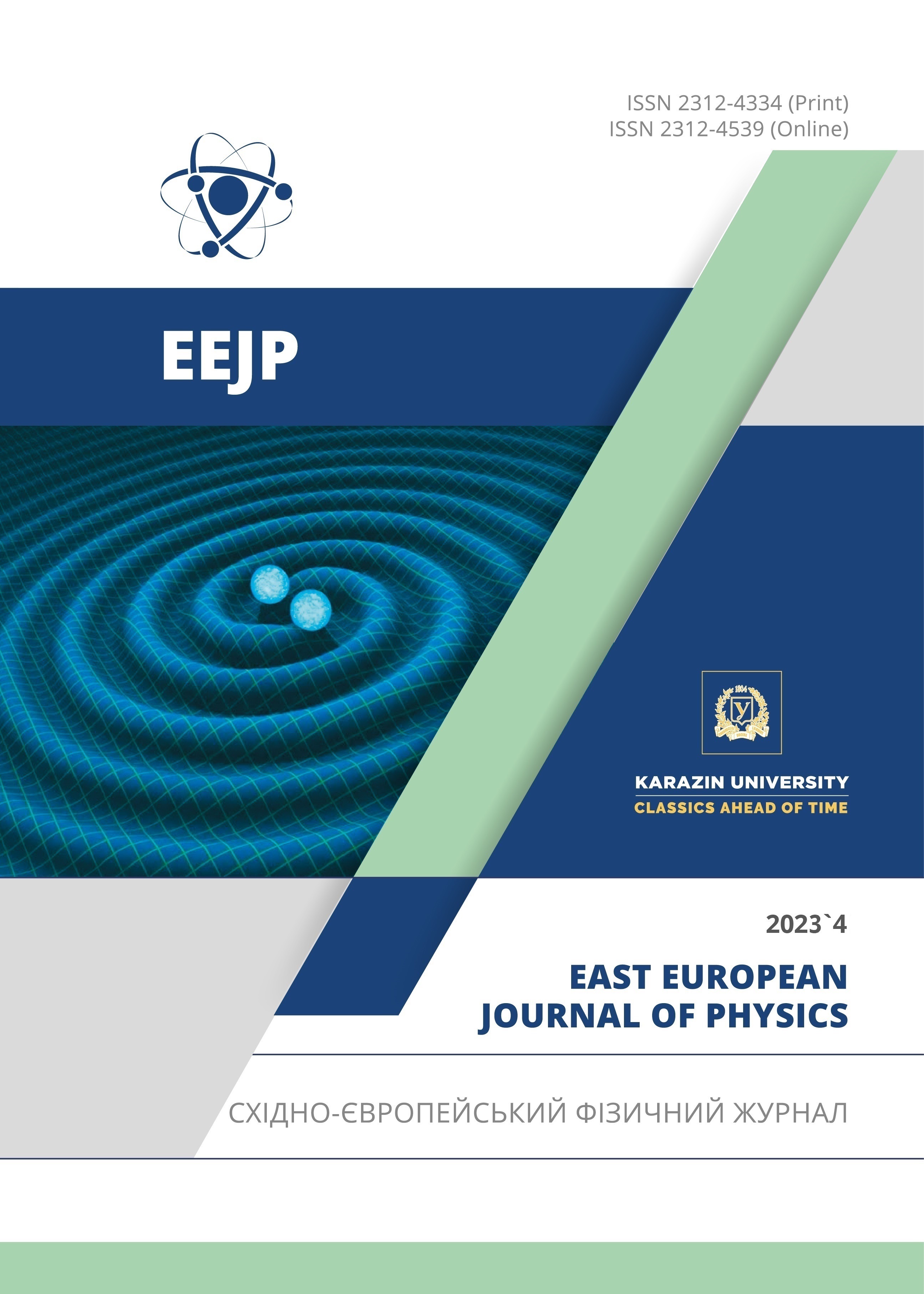Kinematic Calculation of the 16O(γ,4α) Reaction
Abstract
The event distribution over the excitation energy of a system of two α-particles (Ex) is measured for the reaction 16O(γ,4α). It is found that an intermediate excited 8Be nucleus is formed, and the channels of the 8Be nucleus ground state (GS) formation are extracted. After the separation of the GS 8Be nucleus, a broad maximum with a center at ∼ 3 MeV appears in the distribution of Ex, which may correspond to the first excited state of the 8Be nucleus. There are two possible channels for the formation of this state in the reaction - γ + 16O → α1 + 12C* → α1 + α2 + 8Be* →α1 + α2 + α3 + α4 and γ + 16O → 8Be* + 8Be* → (α1 + α2) + (α3 + α4). Each decay mode is reduced to several two-particle systems. For a comprehensive study of the channel for the formation of the first excited state of the 8Be nucleus in the 16O(γ,4α) reaction, a kinematic model for calculating the parameters of α-particles has been developed. The model is based on the assumption of a sequential two-particle decay with the formation of intermediate excited states of 8Be and 12C nuclei. For the kinematic model of the 16O(γ,4α) reaction, a graphical application was created in the Python programming language. The matplotlib library is used for data visualization. To generate random values, a set of functions from the standard random library of the Python programming language is used. Monte Carlo simulations of several distributions for one parameter with a given numerical function were performed. Several excited states of the 12C and 8Be nuclei can contribute to the reaction. The created scheme allows us to choose the relative contribution for each channel of decay, as well as the contribution of a separate level in each channel. To correctly comparison of the experimental data and the results of the kinematic calculation, the α-particles were sorted by energy in such a way that T1sort > T2sort > T3sort > T4sort. As a result of comparing the experimental and calculated data, it was determined that predominantly occurs the process γ + 16O → α1 + 12C* → α1 + α2 + 8Be* → 4α with the formation of the 12C nucleus in states with E0 = 13.3 MeV, E0 = 15.44 MeV, and the 1st excited state of the 8Be nucleus with E0 = 3.04 MeV. The conditions for the identification of α-particles in the experiment for each decay of the stage are determined.
Downloads
References
Y. Kanada-En’yo, Prog. Theor. Phys. 117, 947 (2001). https://doi.org/10.1143/PTP.117.655.
S.A. Sofianos, R.M. Adam, and V.B. Belyaev, Phys. Rev. C. 84, 064304 (2011). https://doi.org/10.1103/PhysRevC.84.064304. (in Ukrainian)
V. Liccardo, M. Malheiro, M.S. Hussein, B.V. Carlson, and T. Frederico, Eur. Phys. J. A, 54, 221 (2018). https://doi.org/10.1140/epja/i2018-12648-5
D. Brink, J.J. Castro, Nucl. Phys. A, 216, 109 (1973). https://doi.org/10.1016/0375-9474(73)90521-6
K. Ikeda, H. Horiuchi, and S. Saito, Prog. Theor. Phys. Suppl. 68, 1 (1980). https://doi.org/10.1143/PTPS.68.1
Y. Funaki, T. Yamada, H. Horiuchi, G. Ropke, P. Schuck, and A. Tohsaki, Phys. Rev. Lett. 101(8), 082502 (2008). https://doi.org/10.1103/PhysRevLett.101.082502
M. Chernykh, H. Feldmeier, H. Neff, P. von Neumann-Cosel, and A. Richter, Phys. Rev. Lett. 98, 032501 (2007). https://doi.org/10.1103/PhysRevLett.98.032501
Y. Funaki, H. Horiuchi, W. Von Oertzen, G. R¨opke, P. Schuck, A. Tohsaki, and T. Yamada, Phys. Rev. C, 80, 064326 (2009). https://doi.org/10.1103/PhysRevC.80.064326
R. Roth, J. Langhammer, A. Calci, S. Binder, and P. Navr´atil, Phys. Rev. Lett. 107, 072501 (2011). https://doi.org/10.1103/PhysRevLett.107.072501
R. Bijker and F. Iachello, Phys. Rev. Lett. 112, 152501 (2014). https://doi.org/10.1103/PhysRevLett.112.152501
F.K. Goward and J.J. Wilkins, Proc. Phys. Soc. A, 65, 671 (1952). 10.1088/0370-1298/65/8/114
C.H. Millar, Can. J. Phys. 31, 723 (1953). https://doi.org/10.1139/p53-068
J.P. Roalsvig, Can. J. Phys. 43, 330 (1965). https://doi.org/10.1139/p65-030
M. Elaine Toms, Nucl. Phys. 54, 625 (1964). https://doi.org/10.1016/0029-5582(64)90439-0
R.A. Golubev and V.V. Kirichenko, Nucl. Phys. A, 587, 241 (1995). https://doi.org/10.1016/0375-9474(94)00789-P
Sergey Afanas’ev, The Journal of Kharkiv National University, Physical series ”Nucleus, Particles, Fields”, 1025(4), 4 (2012). https://periodicals.karazin.ua/eejp/article/view/13573
S.N. Afanasyev, Ukr. J. Phys. 64, 787 (2019). https://doi.org/10.15407/ujpe64.9.787
D.R. Tilley, J.H. Kelley, J.L. Godwin, D.J. Millener, J.E. Purcell, C.G. Sheu, and H.R. Weller, Nucl. Phys. A, 745, 155 (2004). https://doi.org/10.1016/j.nuclphysa.2004.09.059
F. Ajzenberg-Selove, Nucl. Phys. A, 506, 1 (1990). https://doi.org/10.1016/0375-9474(90)90271-M
Copyright (c) 2023 Sergiy Afanas'ev

This work is licensed under a Creative Commons Attribution 4.0 International License.
Authors who publish with this journal agree to the following terms:
- Authors retain copyright and grant the journal right of first publication with the work simultaneously licensed under a Creative Commons Attribution License that allows others to share the work with an acknowledgment of the work's authorship and initial publication in this journal.
- Authors are able to enter into separate, additional contractual arrangements for the non-exclusive distribution of the journal's published version of the work (e.g., post it to an institutional repository or publish it in a book), with an acknowledgment of its initial publication in this journal.
- Authors are permitted and encouraged to post their work online (e.g., in institutional repositories or on their website) prior to and during the submission process, as it can lead to productive exchanges, as well as earlier and greater citation of published work (See The Effect of Open Access).








